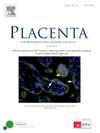Single-cell RNA sequencing reveals altered placental microenvironment due to maternal high-fat diet
IF 3
2区 医学
Q2 DEVELOPMENTAL BIOLOGY
引用次数: 0
Abstract
Background
The prevalence of childhood metabolic diseases has markedly increased in recent decades whereas the effects of maternal nutrients affecting the placental microenvironment are not clearly addressed.
Methods
In the present study, female C57BL/6J mice were fed with a high-fat diet (HFD) or control diet (CON) for 5 weeks prior to mating and then during pregnancy. Single-cell RNA sequencing (scRNA-seq) was used to dissect the placental cell atlas at embryonic day(E) 18.5.
Results
Maternal HFD led to a reduction in the composition of placental labyrinth zone (LZ) trophoblast cells and endothelial cells, together with a diminished LZ area and narrowed fetal vessels, related to a decreased placental efficiency. Pro-inflammatory placental NK1 cells and M1-like macrophages were more apparent in the placenta from HFD dams with inflammation features. Increased glycogen deposition and glycogen trophoblast cells were also detectable in the HFD placenta, likely associated with the altered metabolism of placental NK cells and macrophages.
Conclusions
Maternal HFD before and during pregnancy leads to an altered placental microenvironment with more inflammatory features and abnormal metabolic properties, which provides a better understanding on the mechanisms of intergenerational inheritance.
单细胞RNA测序揭示了由于母体高脂肪饮食导致的胎盘微环境改变
近几十年来,儿童代谢性疾病的发病率显著增加,而母体营养物质对胎盘微环境的影响尚未得到明确解决。方法雌性C57BL/6J小鼠在交配前和妊娠期分别饲喂高脂饲粮(HFD)和对照饲粮(CON) 5周。采用单细胞RNA测序(scRNA-seq)对胚胎日(E) 18.5时胎盘细胞图谱进行解剖。结果母体HFD导致胎盘迷宫区(LZ)滋养细胞和内皮细胞组成减少,LZ面积减小,胎儿血管变窄,与胎盘效率降低有关。促炎性胎盘NK1细胞和m1样巨噬细胞在具有炎症特征的HFD小鼠胎盘中更为明显。在HFD胎盘中也检测到糖原沉积和糖原滋养细胞增加,可能与胎盘NK细胞和巨噬细胞代谢改变有关。结论孕妇孕前和孕期HFD导致胎盘微环境改变,炎症特征增加,代谢特性异常,为进一步了解其代际遗传机制提供了依据。
本文章由计算机程序翻译,如有差异,请以英文原文为准。
求助全文
约1分钟内获得全文
求助全文
来源期刊

Placenta
医学-发育生物学
CiteScore
6.30
自引率
10.50%
发文量
391
审稿时长
78 days
期刊介绍:
Placenta publishes high-quality original articles and invited topical reviews on all aspects of human and animal placentation, and the interactions between the mother, the placenta and fetal development. Topics covered include evolution, development, genetics and epigenetics, stem cells, metabolism, transport, immunology, pathology, pharmacology, cell and molecular biology, and developmental programming. The Editors welcome studies on implantation and the endometrium, comparative placentation, the uterine and umbilical circulations, the relationship between fetal and placental development, clinical aspects of altered placental development or function, the placental membranes, the influence of paternal factors on placental development or function, and the assessment of biomarkers of placental disorders.
 求助内容:
求助内容: 应助结果提醒方式:
应助结果提醒方式:


